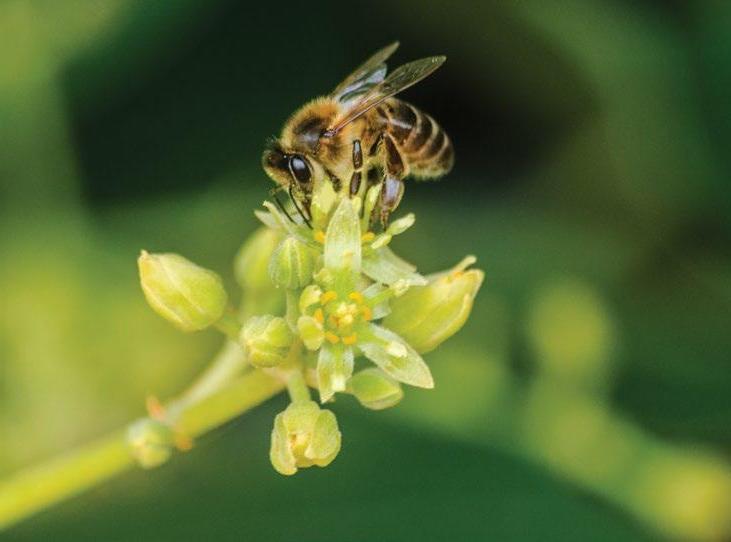
4 minute read
Native flies as pollinators
Researching native flies A national five-year, $5.74million project. as pollinators of horticulture crops
DR DAVID COOK RESEARCH SCIENTIST, DEPARTMENT OF PRIMARY INDUSTRIES AND REGIONAL DEVELOPMENT
Advertisement
Anational $5.74 million five-year project examining the potential for native flies to supplement bees as pollinators of horticulture crops is being led from Western Australia by the Department of Primary Industries and Regional Development (DPIRD).
3 A project examining the potential for native flies to supplement bees as pollinators of horticulture crops is investigating the performance of the western blue-bodied fly (Calliphora dubia) on avocado and blueberry crops.
Funded by Hort Innovation and co-participants from across Australia, the research in WA is focused on examining the performance of native flies as pollinators in avocado orchards and blueberry crops to improve horticultural production. Other national collaborators are investigating avocados, mangoes, seed crops and strawberries. Pollination is vital to the success of many fruit and vegetable crops, with pollination-dependant crops in Australia worth almost $6 billion per year, and in WA around $700 million per year. While bees are the most widely-used and well-known crop pollinators for crops, a range of insects are natural crop pollinators. Flies offer multiple benefits as pollinators in that different species are present year-round, they regularly visit flowers for nectar where their hairy bodies collect and move pollen, they can be mass-reared, and they don’t sting workers. The western golden-haired fly (Calliphora albifrontalis), endemic to the South West of WA, performed well in blueberry glasshouse trials in 2018. However, another native species found around Australia produced even better results in 2019 at DPIRD’s South Perth quarantine glasshouse and in avocado orchards at Busselton. Avocado pollination using the western blue-bodied fly (Calliphora dubia) was three times better than Calliphora albifrontalis, and nearly two-thirds of what bees and all other insects can achieve. This was confirmed by studies that showed that C.dubia fed on avocado flowers three times more often than the western golden-haired fly. When used on blueberries, pollination by C. dubia increased yield by more than one-third compared with C. albifrontalis, as well as producing bigger berries. This comparison between the two fly species is being repeated in 2020 to authenticate the results and provide increased confidence in the findings.
Next steps
The next research effort will be to determine how long flies remain in avocado orchards and examine the effectiveness of measures such as protein lures to encourage flies to remain in the orchard as well as attract other flies in surrounding bushland into the crop.
3 WHILE bees are the most widely-used and well-known crop pollinators for crops, a range of insects are natural crop pollinators.

Flies that visit avocado flowers in mass production of each species so orchards north at Gingin will also be they can be available commercially monitored this year to gauge whether in the horticulture sector as a there is value in examining other fly pollination service. species as potential pollinators to assist bees. The second year of insect surveys at two avocado orchards near Busselton in 2019 found two species of hoverflies were most prevalent, followed by two This will involve determining the dose of x-ray radiation required to render the flies sterile, to ensure they don’t alter the balance of the natural, local species of bibionids, or love bugs, fly populations. and the blowfly, C. vicina found worldwide. , which is The research will confirm the potential of native flies to complement bees as The trials on avocados will this year pollinators for horticulture, and equip be expanded to enclose up to 24 trees growers with a pollination package that under netting to compare the could contribute to ensuring the western blue-bodied fly with productivity and sustainability the global blowfly C. vicina of Australian horticulture. and bees. Three large enclosures will be set up on avocado orchards in Busselton and Pemberton, Pollination is vital to the success of many fruit and vegetable crops. MORE INFORMATION The ‘Managing flies for with a small bee hive placed crop pollination’ project is in one enclosure along funded by the Hort Frontiers with about 5,000 flies of both C. dubia and C. vicina in the other two enclosures. Pollination Fund, part of the Hort Frontiers strategic partnership initiative developed by Hort Innovation, with co-investment from Western Sydney Commercialisation University, The University of New England, The University of Western Australia, The project is investigating the use Seed Purity Pty Ltd and Biological of native flies in the pollination of Services and contributions from the horticultural crops as a pollination Australian Government. service package — from identifying suitable flies for pollination to Contact David Cook, david.cook3@dpird. wa.gov.au, dpird.wa.gov.au, (08) 9368 3084 suitability for commercial rearing, with or go to agric.wa.gov.au and search for the aim of identifying a native fly that ‘flies pollination’. is a good pollinator and can be mass produced on a commercial scale. The final two years of the project will develop rearing techniques for










